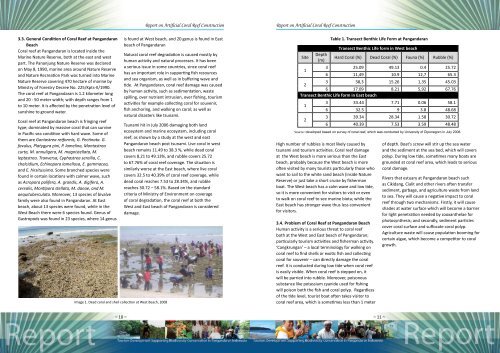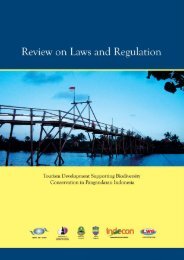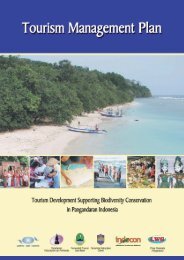Coral Reef Rehabilitation - unwto
Coral Reef Rehabilitation - unwto
Coral Reef Rehabilitation - unwto
- No tags were found...
You also want an ePaper? Increase the reach of your titles
YUMPU automatically turns print PDFs into web optimized ePapers that Google loves.
Report on Artificial <strong>Coral</strong> <strong>Reef</strong> ConstructionReport on Artificial <strong>Coral</strong> <strong>Reef</strong> Construction3.3. General Condition of <strong>Coral</strong> <strong>Reef</strong> at PangandaranBeach<strong>Coral</strong> reef at Pangandaran is located inside theMarine Nature Reserve, both at the east and westpart. The Pananjung Nature Reserve was declaredon May 8, 1990, marine area around Nature Reserveand Nature Recreation Park was turned into MarineNature Reserve covering 470 hectare of marine byMinistry of Forestry Decree No. 225/Kpts-II/1990.The coral reef at Pangandaran is 1.2 kilometer longand 20 - 50 meter width; with depth ranges from 1to 10 meter. It is affected by the penetration level ofsunshine to ground water.<strong>Coral</strong> reef at Pangandaran beach is fringing reeftype; dominated by massive coral that can survivein Pacific sea condition with hard wave. Some ofthem are Goniastrea retformis, G. Pectinata. G.favulus, Platygyra pini, P. lamelina, Montastreacurta, M. annuligera, M. magnistellata, M.leptastrea. Tranversa, Cyphastrea serailia, C.chalcidium, Echinopora lamellosa, E. gemmacea,and E. hirsitussima. Some branched species werefound in certain locations with calmer wave, suchas Acropora polifera, A. grandis, A. digifera, A.cerealis, Montipora stellata, M. danae, and M.aequituberculata. Moreover, 13 species of bivalvefamily were also found in Pangandaran. At Eastbeach, about 13 species were found, while in theWest Beach there were 6 species found. Genus ofGastropods was found in 23 species, where 14 genusImage 1. Dead coral and shell collection at West Beach, 2008is found at West beach, and 20 genus is found in Eastbeach of PangandaranNatural coral reef degradation is caused mostly byhuman activity and natural processes. It has beena serious issue in some countries, since coral reefhas an important role in supporting fish resourcesand sea organism, as well as in buffering wave andtide. At Pangandaran, coral reef damage was causedby human activity, such as sedimentation, wastespilling, over nutrient intrusion, over fishing, tourismactivities for example collecting coral for souvenir,fish anchoring, and walking on coral; as well asnatural disasters like tsunami.Tsunami hit in July 2006 damaging both landecosystem and marine ecosystem, including coralreef; as shown by a study at the west and eastPangandaran beach post tsunami. Live coral in westbeach remains 11.49 to 38.3 %, while dead coralcovers 8.21 to 49.13%, and rubble covers 25.72to 67.76% of coral reef coverage. The situation issimilarly worse at the East beach, where live coralcovers 32.5 to 40.39% of coral reef coverage, whiledead coral reaches 7.53 to 28.34%, and rubblereaches 30.72 – 58.1%. Based on the standardcriteria of Ministry of Environment on coverageof coral degradation, the coral reef at both theWest and East beach of Pangandaran is considereddamage.Table 1. Transect Benthic Life Form at PangandaranTransect Benthic Life form in West beachSiteDepth(m)Hard <strong>Coral</strong> (%) Dead <strong>Coral</strong> (%) Fauna (%) Rubble (%)13 25.09 49.13 0.4 25.726 11,49 10.9 12,7 65.323 38,3 15.26 1,35 45.036 17.09 8.21 5,92 67.76Transect Benthic Life form in East beach13 33.44 7.71 0.06 58.16 32.5 9 3.8 48.6823 39.34 28.34 1.58 30.726 40.39 7.53 3.59 48.48Source: developed based on survey of coral reef, which was conducted by University of Diponegoro in July 2008.High number of rubbles is most likely caused bytsunami and tourism activities. <strong>Coral</strong> reef damageat the West beach is more serious than the Eastbeach, probably because the West beach is moreoften visited by many tourists particularly those whowant to sail to the white sand beach (inside NatureReserve) or just take a short cruise by fishermanboat. The West beach has a calm wave and low tide,so it is more convenient for visitors to visit or evento walk on coral reef to see marine biota; while theEast beach has stronger wave thus less convenientfor visitors.3.4. Problem of <strong>Coral</strong> <strong>Reef</strong> at Pangandaran BeachHuman activity is a serious threat to coral reefboth at the West and East beach of Pangandaran;particularly tourism activities and fisherman activity.‘Cangkrungan’ – a local terminology for walking oncoral reef to find shells or exotic fish and collectingcoral for souvenir – can directly damage the coralreef. It is conducted during low tide when coral reefis easily visible. When coral reef is stepped on, itwill be parried into rubble. Moreover, poisonoussubstance like potassium cyanide used for fishingwill poison both the fish and coral polyp. Regardlessof the tide level, tourist boat often takes visitor tocoral reef area, which is sometimes less than 1 meterof depth. Boat’s screw will stir up the sea waterand the sediment at the sea bed, which will coverspolyp. During low tide, sometimes many boats aregrounded at coral reef area, which leads to seriouscoral damage.Rivers that estuary at Pangandaran beach suchas Cikidang, Cialit and other rivers often transfersediment, garbage, and agriculture waste from landto sea. They will cause a negative impact to coralreef through two mechanisms. Firstly, it will causeshades at water surface which will become a barrierfor light penetration needed by zooxanthelae forphotosynthesis; and secondly, sediment particlescover coral surface and suffocate coral polyp.Agriculture waste will cause population booming forcertain algae, which become a competitor to coralgrowth.~ 10 ~~ 11 ~




